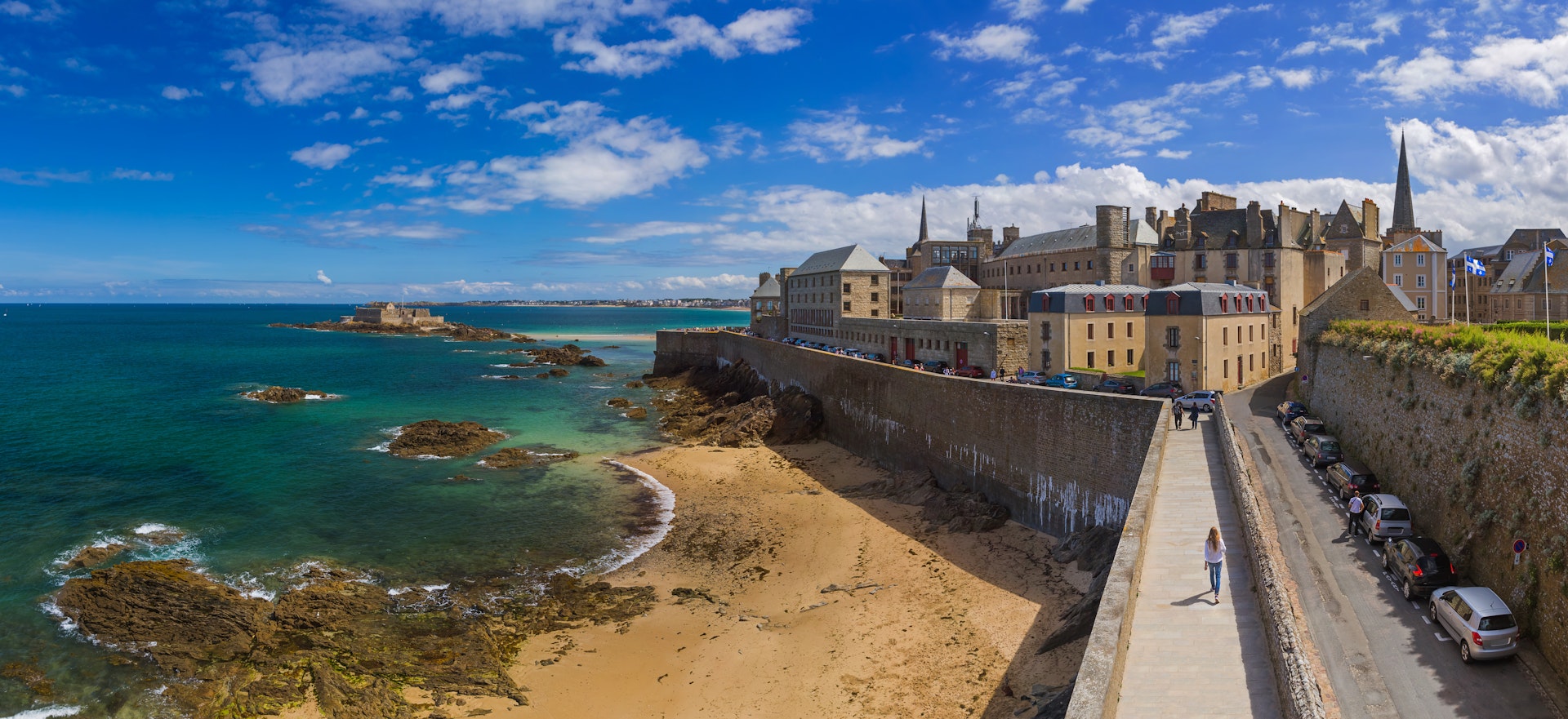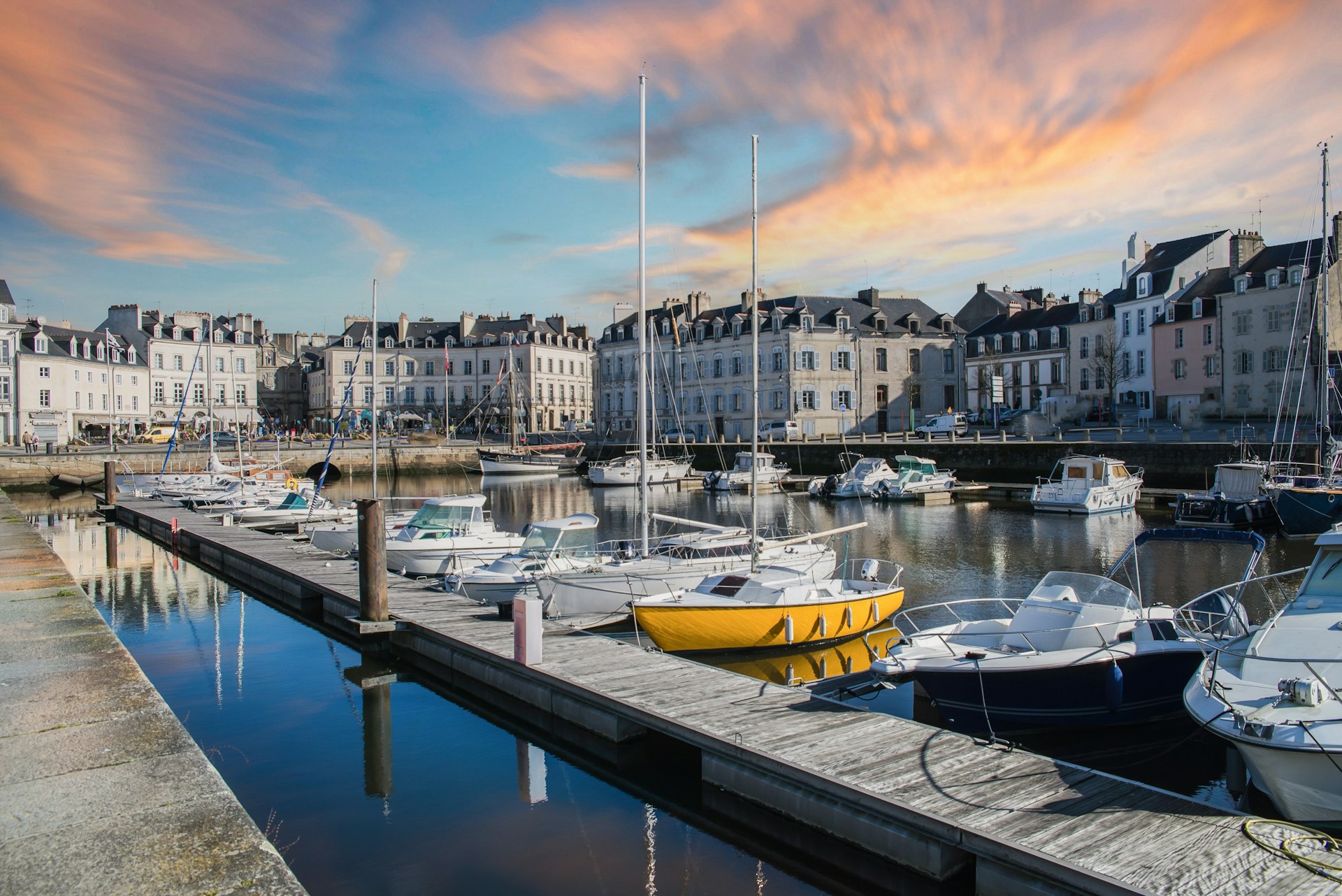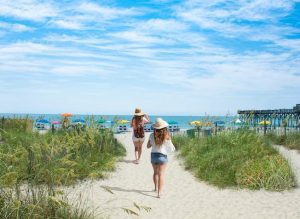
With its countless stone-walled crêperies, traditional dancing Fest Noz festivals and road signs translated in Celtic language, Brittany loves to be unapologetically Breton. You will fall under the charm of this land shaped by the ocean, where fishermen hum centuries-old sea shanties at the local bar and tide times determine the course of the whole day.
If you are not one to be put off by below-average water temperatures and the occasional drop of rain, here are 15 unmissable things to see, watch and experience in Brittany. The spectacular scenery and fresh catch of the day are well worth the effort.
1. Get lost in the charming streets of Brittany’s medieval towns
There is no shortage of defensive walls, granite castles and cobbled streets in Brittany. The region is home to a long list of towns and villages straight out of the Middle Ages, from Dinan’s colorful half-timbered houses to the flowery streets of Rochefort-en-Terre, through Moncontour, Vitré or Josselin – each with its own history of fierce battles, and lucrative mercantile trading.
Often topping the list of Brittany’s most picturesque villages, Locronan has been part of France’s select club of classified historic monuments since 1924. Perched on a mountain less than 10 km away from the sea, you can catch breathtaking sights of Douarnenez Bay. The town also has a rich history, as a convergence point for different faiths and many Druid sites survive today. There’s also a yearly Troménie procession paying tribute to the village’s Catholic patron saint, Saint Ronan.
Planning tip: The village puts on an enchanting Christmas festival in early December with concerts, shows and activities, all in true Breton style.
 A section of the Old Customs Officers’ Path on the Pink Granite Coast with view of the Ploumanac’h lighthouse © Manfred Gottschalk / Getty Images
A section of the Old Customs Officers’ Path on the Pink Granite Coast with view of the Ploumanac’h lighthouse © Manfred Gottschalk / Getty Images
2. Take a romantic walk along the Pink Granite Coast
Stretching over a dozen kilometers between Perros-Guirec and Trébeurden, the Pink Granite Coast owes its name to the blush-color rocks with a rare chemical composition formed from volcanic activity some 300 million years ago. Take the GR34 footpath, which meanders along the coast, and be prepared for some truly splendid sights as the rocks’ soft pink meets shades of sea blues and earthy greens. Sunset lighting only adds to the magic.
Local tip: Keep your eyes peeled for some of the more fantastically shaped rocks, including the “painter’s palette” and the “crab claw” in Trégastel, or the “upside down bottle” and even “Napoleon’s hat” in Ploumanac’h. And don’t miss Mean Ruz, an active lighthouse near Ploumanac’h that is emblematic of the region, which is built – you guessed it – out of pink granite.
3. Tour Finistère’s famous lighthouses
Finistère’s famous lighthouses dotted along the coast – proudly displaying their names in capital letters as they guide ships through the night – are a trademark of the region. Ile Vierge, Saint Mathieu, Stiff, Trézien, or Petit Minou are among the lighthouses you can visit. Don’t count on an elevator to help with what can be a tough climb (up to several hundred steps, depending on which you visit) but the views are worth it.
Planning tip: Be aware that many lighthouses are shut to the public during the winter months. Also make sure that you check access details before you visit as some, such as Ile Vierge, have specific requirements depending on tide times.
 Taking in the sea views from a tunnel at the Fort des Capucins a rocky islet on the Crozon peninsula
Taking in the sea views from a tunnel at the Fort des Capucins a rocky islet on the Crozon peninsula
4. Trek around the beautiful coastlines of the Crozon peninsula
For some postcard pictures, head to the Crozon peninsula, where the rugged cliffs falling into turquoise waters attract ever-larger crowds of tourists every year. The area’s wild landscapes are nevertheless impeccably preserved.
The GR34 route, a long-distance walking trail that follows Brittany’s entire coastline from Mont Saint-Michel to Saint-Nazaire, will take you around the peninsula, making for almost 150 km worth of pine trees and fragrant heather overlooking small coves and sandy beaches. You can access the footpath year-round from many different access points and will quickly become familiar with the red-and-white tags indicating you are on the right way.
5. Headbang to your new favorite song in Rennes
The capital of Brittany is also less-officially known as one of the epicenters of rock music in France, a reputation that has stuck since the late ’70s when the city’s annual Trans Musicales festival started growing in popularity. Since then, Rennes has become an exciting musical hub, packed with festivals on a quasi-monthly basis.
Interested in moped races by the day followed by an eclectic selection of music gigs at night? Check out Rock’N’Solex in May. Fancy discovering both traditional and experimental takes on Breton folk music? Have a look at the Yaouank festival in November. Whether you are a punk rock purist or keen to branch out of your musical comfort zone, you can be sure there will be a scene for you.
 Explore the 12th-century fortifications on the pirate city of Saint-Malo © Tatiana Popova / Shutterstock
Explore the 12th-century fortifications on the pirate city of Saint-Malo © Tatiana Popova / Shutterstock
6. Revel in the lives of the famous pirates of Brittany
The 16th and 17th centuries saw the advent of notorious and terrifying French pirates, many of whom kept their ships in the fortified city of Saint-Malo, which thus came to be known as a cité corsaire (pirate city). Head for the port, where you will spot Le Renard and L’Etoile du Roy, replicas of historical privateer (pirate) ships on which you can set sail for as little as half a day or up to a whole weekend.
If you would rather remain on dry land, take a walk around the city’s 12th-century fortifications to take in both sea and city views. On a small island just 200m away you will see the National Fort, built in the 17th century on the orders of the King Louis XIV to protect the immense riches accumulated in the city by his privateers.
Planning tip: Twice a year, around March and September, tidal coefficients surpass 100, a natural phenomenon that signifies an extreme tidal force. Keep an eye on those numbers online because in Saint-Malo this is prime time to observe massive waves dramatically crash against the city walls. Official coefficients are released via the Naval Hydrographic and Oceanographic Service (SHOM) and displayed at the harbor master’s office.
 Do not leave Brittany without indulging in a plate of freshly shucked oysters © EQRoy / Shutterstock
Do not leave Brittany without indulging in a plate of freshly shucked oysters © EQRoy / Shutterstock
7. Stuff your face with fresh oysters in Cancale
Sure, Normandy has Mont Saint-Michel… but Brittany has Cancale, where you can not only see Mont Saint-Michel from a distance but do so while sitting on a lovely harbor eating some of the region’s best oysters. The reputation of the huître de Cancale, the Cancale oyster, is established across France – this is a must-do for experienced oyster devourers as much as hesitant first-timers.
Local tip: Head to the town’s oyster market, which welcomes eight local oyster aquaculturists year-round, and buy some produce to enjoy on the spot or on the go. Before you know it, you will be expertly differentiating between flat and cupped oysters, two of Cancale’s specialities.
8. Take a surfing lesson
Who said France’s best surfing spots could only be found on the south west coast? Although colder, Brittany’s waves are attracting a growing number of water sports enthusiasts. La Torche in Finistère is one of the most prized locations, but don’t hesitate to branch out to lesser-known options, such as the excitingly named Bay of the Dead, located near the scenic Pointe du Raz, or Plouharnel in the Morbihan.
Not a surfer? Not a problem. Most surfing schools will let you rent bodyboards at a lower cost which require next to no skill or water sport experience. Happy wave jumping.
Planning tip: You will likely be given the option to rent a wetsuit with your board. Take it or bring your own, but don’t risk getting cold in the water, because you will.
9. Kayak through a secluded lagoon
It is not hard to see why Les Glénan archipelago is often compared to Tahiti. Made of seven islands and a dozen smaller islets, Les Glénan offers an exceptional – and largely uninhabited – spectacle of sandy beaches and translucent water. As the home of an international diving center and a world-famous sailing school, it will come as no surprise that it can only be reached by boat.
There are several options to visit, with shuttle boats connecting to various ports on the mainland between April and September. Prioritize the warmer summer months, when you can rent kayaks to tour the archipelago on your own. It’s not that often you get to disembark for a nap on a totally deserted isle.
 This is the largest gathering of menhir (upright rocks) in the world © Justin Foulkes / Lonely Planet
This is the largest gathering of menhir (upright rocks) in the world © Justin Foulkes / Lonely Planet
10. Wander around thousands of prehistoric menhirs
Next to the small seaside town of Carnac, some 3,000 menhirs, or upright stones, are sitting in three alignments – the largest gathering of prehistoric stones in the world. The site was built around 6,000 years ago, even before England’s Stonehenge, for reasons still shrouded in mystery. Walk the footpaths circling the alignments or join a guided tour to learn more about the wild and wacky hypotheses scientists have put forward to explain the collection.
Planning tip: The footpaths that are accessible year-round will only let you view the stones from the outside. You can also walk freely through the alignments from October to April. If you are visiting during the summer months, however, you will be required to book a guided tour.
 Explore the windy historic streets of the harbor-side city of Vannes © Pascale Gueret / Shutterstock
Explore the windy historic streets of the harbor-side city of Vannes © Pascale Gueret / Shutterstock
11. Go harbor-hopping in the Gulf of Morbihan
Small towns with pretty harbors abound in the Gulf of Morbihan. Pick and mix between Auray, Le Bono, Larmor Baden, Port Navolo or Port du Crouesty. Make sure you don’t miss the medieval city of Vannes with its windy, historical streets.
With up to 60 islands small and big sitting inside the Gulf, you might also consider booking a boat trip. A handful of islands can be visited and explored thanks to plenty of panoramic footpaths, the most popular of which are also the largest: Ile d’Arz and Ile aux Moines.
Detour: At low tide, you will be able to walk to Ile Tascon from Saint-Armel on the mainland and get around the island in just two to three hours. The area is known for its high concentration of birds. Make sure you don’t get so lost in contemplation that you forget the rising water and get stuck there.
12. Re-enact the legend of King Arthur in the Brocéliande Forest
Merlin’s Tomb, the Church of the Holy Grail or the Valley of No Return may sound like they have no place in the real world, yet they are open to flesh-and-bone visitors in the forest of Brocéliande, also known as Paimpont Forest. The site, famous for its centuries-old legends and myths, served as the setting for Arthurian novels written by Chrétien de Troyes in the 12th century.
Trees that have lived through the last millennium overlook small ponds and quiet streams, creating an atmosphere that seems suspended in time. There is no shortage of options to make the most of your time in the forest, whether you are renting a bike, following a guide on a storytelling-themed tour, or simply wandering around on foot.
Planning tip: The forest is largely private, which means that only a small area and a selection of sites are completely open to the public. To further complicate matters, some zones may be shut when it is hunting season (from mid-September to the beginning of April), so plan ahead and check if access restrictions apply by visiting the Brocéliande tourist office in Paimpont. You can also find online maps of the forest with recommended routes for spring and summer or autumn and winter, as well as a useful guide to visiting the forest. Do not ignore any hunting-related sign that you encounter during your visit (pull out Google Translate if you need to).
13. Ride a certified Breton horse in Lamballe
Brittany is a land of horses. But not just any horses: the Breton breed is as imposing as it is gentle, and typically suited to carriage-pulling and agricultural work. To see some of the region’s best specimens and learn more about their history, head to the Haras National in Lamballe, a stud farm established in 1825 and which now boasts an impressive collection of horse-drawn carriages and a historical harness room.
In addition to guided tours, you can book a 30-minute carriage ride around the town center or in the nearby park. During the school holidays, children can also spend half a day learning the basics of stable work. Make sure you book in advance.
14. Dive into Brest’s fascinating maritime history
Maritime history and culture have long permeated the city of Brest, which is still a key military base for the French Navy. Right in the city center, the Castle of Brest doubles as the National Maritime Museum, which recounts centuries of sea-bound expeditions through ship models, paintings and sculptures.
The city sits facing the majestic roadstead of Brest, which, at 180 sq kms, is one of the largest in the world. Jump on a paddleboard, a kayak, a cruise or a sailing boat to explore this gigantic bay and its many spots of natural beauty.
Detour: A 45-minute drive from Brest – or just on the opposite side of the roadstead if traveling by water – lies the ship graveyard of Landévennec where decommissioned vessels are moored while they await dismantling. You can catch a glimpse from various spots on the ground or watch from a safe distance at sea. An experience that, albeit slightly spooky, is definitely out of the ordinary.
 Typically a bolée of cider is consumed with a Breton galette (a savory crêpe) © sylv1rob1 / Shutterstock
Typically a bolée of cider is consumed with a Breton galette (a savory crêpe) © sylv1rob1 / Shutterstock
15. Work your way through the crêperie menu for breakfast, lunch and dinner
Discussing Brittany without mentioning crêpes would be like passing on pizza while visiting Naples. In fact, you will find it hard to go more than 10 minutes without walking past one of the cozy crêperies that are so typical of the region. And your trip cannot be complete without having sampled an extensive selection of sweet and savory toppings.
Granted, crêperie etiquette can seem tricky. It is okay (and encouraged) to order a second galette if you are still hungry after your first one – and the same goes for crêpes. You are meant to drink cider with your meal, and it will come in a tiny bowl called a bolée. And if you have fearlessly chosen the galette à l’andouille, which is filled with a pungent type of sausage made from pork guts – then yes, that smell is normal.
Planning tip: It is not a given that your local crêperie will have an English-translated menu. Be aware that in many parts of the region, savory crêpes are called galettes and that they are made with buckwheat. It gives them a deliciously nutty, smoky taste and also means that they are gluten-free. A crêpe de froment is for your sweet tooth only and is made with standard wheat flour.



